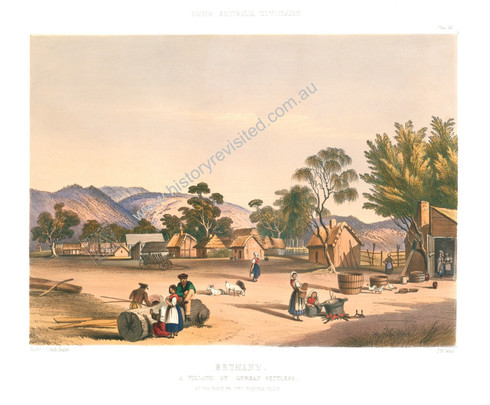 Loading... Please wait...
Loading... Please wait...All prices are in All prices are in AUD
Categories
- Home
- Giclee Prints
- Giclee Angas Bethany Barossa South Australia Illustrated German
- Home
- Giclee Prints
- South Australian Scenes
- Giclee Angas Bethany Barossa South Australia Illustrated German
- Home
- Giclee Prints
- South Australian Scenes
- George French Angas 1846-47
- Giclee Angas Bethany Barossa South Australia Illustrated German
Product Description
George Fife Angas, "South Australia Illustrated", Bethany, Village, German Settlers, Barossa Hills, Pastor Gottlard Fritzsche, Skjold
"Bethany, a German Village, at the Foot of the Barossa Hills" (South Australia, circa 1846)
Archival limited edition Giclee print ( /300) after the original hand colored lithograph by J.W. Giles after artist George French Angas for his ambitious publication "South Australia Illustrated".
Originally published in London between 1846 - 47, the hand colored lithographic prints were sold to 200 subscribers, eager to see what this brave British prototype freely-settled colony had to offer after a decade of settlement. How many of those 200 original hand coloured lithographs still exist has prompted issuing this high quality light-safe inkjet process printed on cotton conservation paper.
Image size = 32 x 37cm (12 2/3 X 14 inch)
Issued with Limited Edition Certificate.
DESCRIPTION: In this scene we see the traditionally dressed settlers in the foreground with at least 15 cottages in the rear, that bear a strong resemblance to those in Northern Germany and Poland and are built along Prussian lines with the farmhouses facing the street and allotments of land at the rear. A stand of old eucalyptus trees populate either side of wood fence, with a backdrop of rolling hills showing sparse vegetation. In the midst of the cottages appears to be larger building with a peaked roof, possibly the church. In front of the cottages is an idle empty wooden ribbed wagon. In the mid foreground a large section a tree trunk is the focus of two couples: one green shirted man is balanced cross legged on the tree while another, with an intriguing front brimmed hat, is toiling on the other side. One women is crouched, perhaps scraping the side of the trunk, while the other appears to be nursing a baby. To their right are three grazing goats, another woman walks back to the cottages with a bucket in hand. Further to the right is dominated by women-folk: two are tending a large boiling copper, while just behind them are three coopered half wooden barrels (a hint to the future wind industry that dominates that very region per-chance?), three jugs, one metal handled bucket and four round trays that may be feeding the three red crested chickens . A blue apron-ed lady walks towards us from the under the shade of the large eucalyptus, while two women stand in an open doorway are seemingly looking at the artist, one with a small bucket. Most of the ladies are dressed the traditional "Dirndl" fashion popular in the 18th and 19th centuries, consisting of a bodice, skirt , blouse and apron. In this case most bodices are red and the skirts are a rich dark blue.
Village of Bethany (Benanien) & Pastor Gotthard Daniel Fritzsche (1797-1863)
Gotthard Daniel Fritzsche was born in Bad Liebenwerda, a spa-town in the Elba-Elster district of southwestern Brandenbug, in the Electorate of Saxony. On entering the ministry he was banned from the State Church as he was against the Prussian Union. Under the reign of Frederick William III of Prussia sought to unite the Lutheran & Calvinist (Reformed) denominations into the United Church of Prussia. The King’s agenda was not well received by many Lutherans, of whom Fritzsche was one. He joined the “Old Lutherans”, a minority who resisted the change to their Lutheran traditions. In 1836 he met with George Fife Angas in England to broker assistance to pay for passage to the Colony of South Australia. In July 1841 Fitzsche and his followers set sale on the Skjold. South Australia was to be "A Paradise of Dissent": as a free colony, denominational barriers were considered a barrier to desirable hard working immigrants, especially as there would be no convict labor. In 1842 more Prussian immigrants joined Fritzsche's followers, and they ventured beyond the Adelaide Plains towards the Barossa Valley. These German migrants settled in Lobethal and Bethanien (Bethany). Friztche chose to live in Lobethal, were he died in 1863. A few years after settlement a division in the Lutheran church in Australia emerged. Paster Kavel, who had settled in Klemsic, on town Lot 477, developed a "millennialistic" viewpoint. Fritzche disagreed with this approach among other pivotal ideas. When the original lithograph was being published back in London in 1846-47, a synod gathering at Bethany in August 1846 culminated in the Australian Lutheran division. Kavel’s followers formed their own synod while Fritzsche and his supporters formed the Evangelical Church of South Australia.
Bethany, originally Bethanien, was founded in 1842 Fritzche and to this day, is the Barossa Valley’s oldest German settlement. It was Pastor Gotthard Fritzsche, who had arrived on the "Skjold", who set out beyond the Adelaide Plains. The name of their village is an indication of the settlers devotion. The Village has a strong resemblance to those in Northern Germany and Poland and are built along Prussian lines with the farmhouses facing the street and allotments of land at the rear. Some of the original structures have been restored and are in use today. Another Barossa settlement significant to the Barossa Valley German migrants is also included in Angas' illustrations in 1840s, being Lyndoch.
Product Videos
-
 Bethany to Vin...Discover the Eastern foothills of the Barossa Valley on a trai...
Bethany to Vin...Discover the Eastern foothills of the Barossa Valley on a trai...












